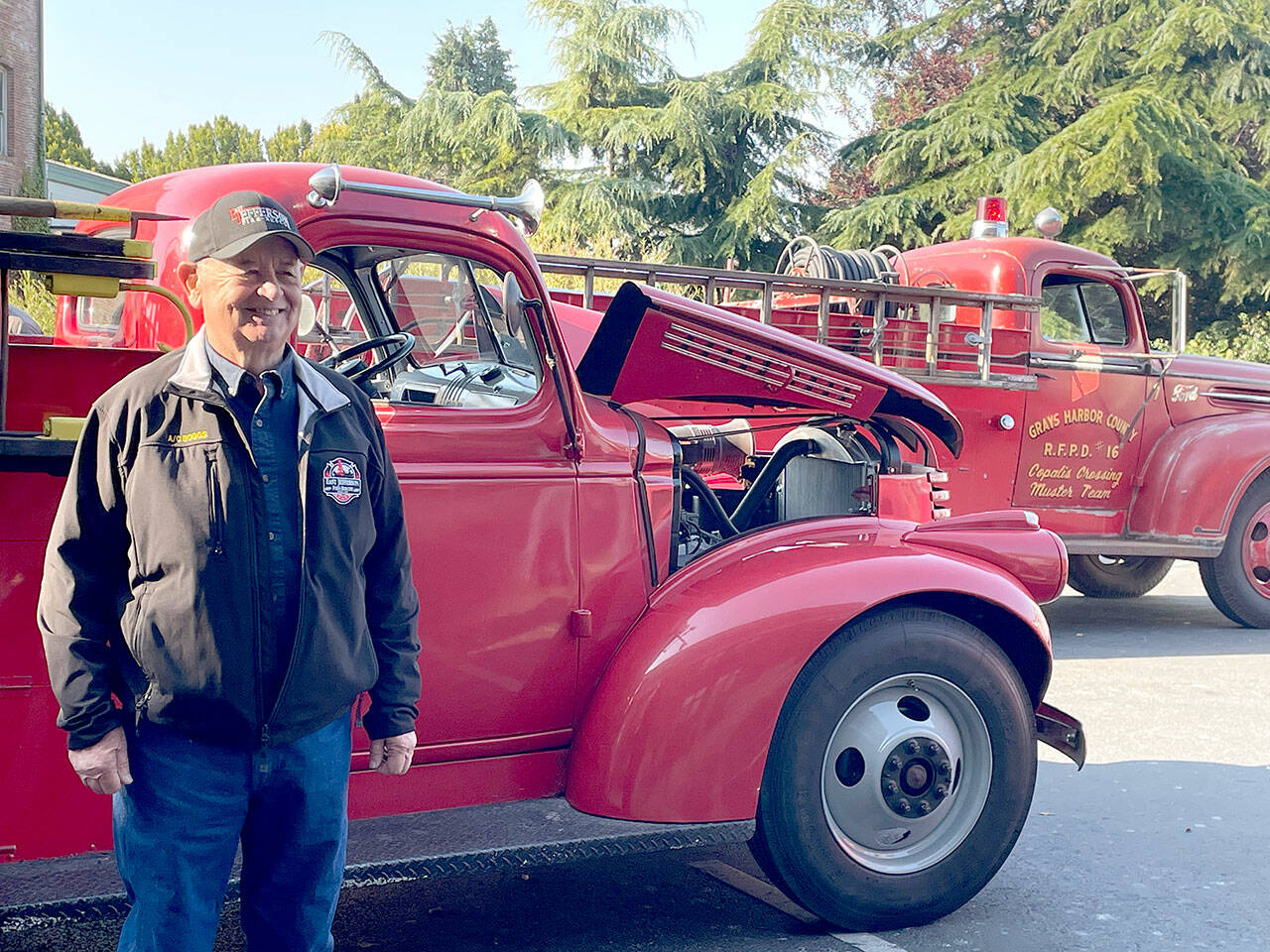CHIMACUM — Battalion chief Justin Fletcher was less than 90 minutes into his shift at the East Jefferson Fire Rescue Station 11 in Chimacum when a call came in that a motorcycle and a pickup had collided.
Fletcher quickly headed to the bay where firefighters Trevor Bergen and Andy Dalrymple were already dressed in their gear. He jumped into his red Silverado and headed out, followed by a fire engine, lights flashing and sirens sounding.
It was another day responding to vehicle wrecks, medical emergencies and fires, handling hazardous waste and conducting water rescues for East Jefferson Fire Rescue (EJFR), which celebrated its 150th anniversary Saturday with a day of events, demonstrations and activities at Port Townsend City Hall.
The development of the department from an all-volunteer bucket brigade in 1872 to today’s highly skilled corps of medical and fire professionals has spanned many changes in training, equipment and personnel.
Fire departments like EJFR increasingly prefer firefighters who are certified as EMTs or paramedics, a reflection of the nature of the emergencies they see.
The motorcycle-pickup collision, like about 74 percent of East Jefferson Fire Rescue’s responses, for example, was medical and not fire-related.
Fletcher is a certified EMT as well as one of three battalion chiefs, a new position at East Jefferson that was added in September 2021.
A challenge for the district has been recruiting EMTs, paramedics and firefighters. East Jefferson and Port Ludlow, with which it has an interlocal agreement, are understaffed but are finding it extremely difficult to find candidates, Chief Brett Black, who oversees both districts, has said.
This is different from years past, Fletcher said.
“It’s tough right now,” Fletcher said. “Fifteen years ago, when I tried to get on [as a firefighter], there were 200-300 applicants for one spot. Now there are so many vacancies. Not a lot of young kids are interested in blue-collar work, but it’s a good-paying, stable job.”
A shortage of firefighters means slimmed-down response teams.
For example, the minimum response team to the motorcycle-pickup collision would ideally have consisted of a battalion chief, four to five firefighters and two engines. In this case, Fletcher and two firefighters and one engine raced to the site.
As battalion chief, Fletcher’s role was overseeing the scene, providing direction and asking for assistance, if needed.
“When we don’t have enough people, I jump in” to help the firefighters, he said.
Fletcher said he knew he wanted to be a firefighter from the time he was 18 years old. The Port Angeles High School graduate became an intern with EJFR (a common way firefighters enter the ranks) in 2007, and two years later he was hired.
At not yet 40, Fletcher has already seen a transformation in equipment and technology that has changed the way he and other firefighters do their jobs.
Fletcher’s call tools include two cell phones, a tablet computer and a GPS device.
He especially likes plugging in an address into the GPS.
“I used to write it [the address] on the back of my hand and hope I could read it,” he said. “It was really bad when your hand started to sweat.”
Debbie Tillman, the District 2 commissioner for East Jefferson Fire Rescue, said new materials and technical developments have contributed to tools that are lighter, more reliable and easier for firefighters to use.
“The brass nozzles were extraordinarily heavy and difficult to control the stream,” said Tillman, who started her career as an EMT and then moved into firefighting before retiring in 2016 to return to school to become a nurse practitioner.
“New nozzles made out of Pyrolite [a man-made material], break quicker than brass, but they are much lighter and easier to adjust. With brass, you have to change out the nozzle to change the stream.”
Chuck Boggs, who retired as East Jefferson Fire Rescue assistant chief in 2010 after 39 years, added, “Even the couplings on the hose are made of Pyrolite also, and they’re half the weight of a brass coupling.”
For Tillman, one of the most striking changes in EJFR has been the acceptance of women into firefighting.
“Women are now part of it without even thinking about it,” Tillman said. “When I started, women were volunteer auxiliary or support staff. I came in at the right time, in the late ’90s, when women were starting to join as firefighters.”
When he began as a firefighter in 1971, Boggs said, the department didn’t even have an ambulance.
“The mortuary would send for bad auto accidents, basically a hearse,” Boggs said. “Two guys would come out, put you on a simple gurney, shove you in the back and take you to the hospital.
“The hospital emergency room was two beds separated by a curtain and no doctor or nurse on duty,” he said.
Today, East Jefferson does have ambulances, and although the aging vehicles need to be replaced, there is no risk of patients being whisked from fires, wrecks or other emergencies in a hearse.
And while a great deal has changed in the profession, Fletcher said that basic mission of firefighting to serve the public has endured.
Asked if there is a 911 call that the station will decline to respond to, he said, “We get calls to rescue cats out of trees, but we don’t do that. It’s actually dangerous for the cat and for us.”
In the general election on Nov. 8, Port Ludlow voters will decide whether to merge Port Ludlow Fire & Rescue into East Jefferson Fire District.
________
Reporter Paula Hunt can be reached at paula.hunt@soundpublishing.com.

